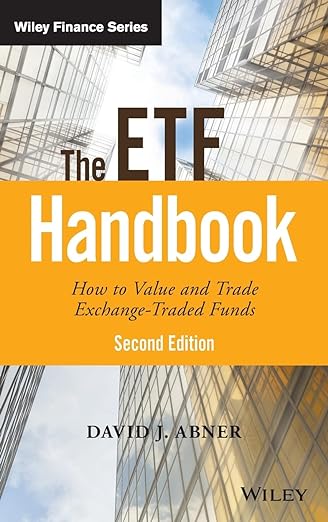
|
Best ETF Investing Books
Best books on ETF investing on Amazon. 2024 highest rated and top selling ETF investing
books to read for ETF investors.
|
|
Buy it on
Amazon.com:

|
Best ETF investing book - The ETF Handbook: How to Value and Trade Exchange Traded Funds, by David J. Abner
This book is mainly for financial advisors and professional investors. It provides a thorough overview of Exchange Traded Funds (ETFs), which are like mutual funds but traded like stocks. ETFs are useful for managing money, reducing risks, following market indexes, and providing flexible, low-cost investment options.
The content is aimed at advanced traders familiar with the stock and bond markets, covering topics like ETF pricing, portfolio integration, and user strategies.
The author, David J. Abner, is a seasoned ETF trader with over 20 years of experience at major firms like Bear Stearns and Wisdom Tree.
View on Amazon.com »
Review
The ETF Handbook is structured in four parts detailing the different types of ETFs, methods for valuing ETFs, trading strategies, and sources for ETF-related information.
The book is detailed and professional but may be too technical for casual investors. Abner’s writing is clear, methodically explaining how ETFs are created and their differences from other funds like mutual funds and closed-end funds.
Useful extras include lists of ETF providers and a comprehensive collection of websites about ETFs. A notable miss is the lack of ticker symbols for quick reference in one of the appendices. This book is a good resource for anyone looking to understand the current and future landscape of ETFs.
|
|
Buy it on
Amazon.com:

|
Best ETF investing book - Investing Made Simple: Index Fund Investing and ETF Investing Explained in 100 Pages or Less, by Mike Piper
This book is great for beginners who want to learn the basics of investing in modern markets, focusing on ETFs and index funds rather than individual stocks and bonds. It highlights the benefits of these popular investment types.
Written in easy-to-understand language, it covers how to choose mutual funds, evaluate financial advisors, avoid common investment mistakes, and plan for retirement.
View on Amazon.com »
Review
At only 100 pages, this book won’t show you how to consistently beat the market or provide a deep dive into complex financial strategies. Instead, it offers a solid introduction to ETFs and index mutual funds, ideal for new investors.
Piper's straightforward writing and the book's clear structure make the material accessible. The summaries at the end of each chapter help reinforce the main points. While its brevity is both a strength and a limitation, this book is an excellent start for those new to investing.
|
|
Buy it on
Amazon.com:

|
Best ETF investing book - The Ultimate Guide to Trading ETFs: How to Profit From the Hottest Sectors in the Hottest Markets All the Time, by Don and Caroline Dion
This book will help you navigate the increasingly popular world of Exchange Traded Funds. It's aimed at those who want to understand and make the most of ETFs in their investment strategies.
The book discusses various types of ETFs including those focused on stocks, bonds, commodities, and international markets, and particularly emphasizes index funds. It also covers how to evaluate ETFs and strategic asset allocation.
View on Amazon.com »
Review
Despite its ambitious title, the book is a practical guide to understanding and using ETFs effectively in your investment portfolio.
The authors provide a straightforward look at the basics without promising any secret strategies for market success. The discussion on diversified investment strategies to manage risks is particularly useful.
More detailed coverage on high-risk leveraged ETFs would have been beneficial, especially for investors drawn to these for their potential high returns.
The book is well-organized and written in clear language, making it a solid choice for those looking to deepen their understanding of ETFs.
|
|
Updated on 7/5/2024.
|